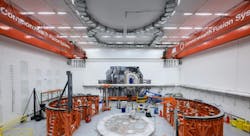SPARC Flies: Google Signs Up for 200-MW Nuclear Fusion of the Future
Turns out that the digital infrastructure industry is so committed in its desire for future nuclear energy that it’s willing to sign up and pay for technology which doesn’t even commercially exist yet.
Google has committed to a 200-MW offtake agreement with nuclear fusion firm Commonwealth Fusion Systems from its first-ever power plant to be sited, if and when it’s approved and built, in Chesterfield County, Virginia. The power purchase agreement (PPA), like those around small modular nuclear fission startups, will only take effect when CFS builds, commissions and connects its ARC plant to the grid possibly in the 2030s.
Nuclear fission, the type of reactor power currently in operation throughout the world, uses the energy released from splitting of nuclei to create power generation, while fusion experiments are using lasers to create reactions forming a larger nuclei from the combination of smaller ones. The theory behind fusion is bringing to human scale the same force powering the sun, but no commercially viable work has been achieved other than experimental breakthroughs by the U.S. Lawrence Livermore National Laboratory and other entities globally.
CFS, which Google has supported as an investor since 2021, late last year announced plans to build the nuclear fusion plant at the James River Industrial Park on land currently owned by utility Dominion Energy Virginia. Virginia leads the U.S. in data center density and is working on ways to meet that growing load from artificial intelligence and cloud-based computing facilities.
Google is pursuing multiple PPAs around potential nuclear generation. Nuclear power plants operate at high-capacity factors and do not release carbon emissions.
“By entering into this agreement with CFS, we hope to help prove out and scale a promising pathway toward commercial fusion power,” Michael Terrell, head of advanced energy at Google, said in a statement. “We’re excited to make this longer-term bet on a technology with transformative potential to meet the world’s future energy demand, and support CFS in their efforts to reach the scientific and engineering milestones needed to get there.”
No SMR plants have been approved or built in the U.S., either, although federal regulators are reviewing projects by X-energy, NuScale Power and others. Nuclear fusion, however, has yet to move beyond the experimental and research stage.
In November 2024, CFS reported that it successfully built and tested a record-breaking electromagnet called the Central Solenoid Model Coil, which could help validate the performance of high-temperature superconducting magnets needed for a “tokamak” net fusion machine, called SPARC, that the company is building to demonstrate its technology.
The donut-shaped SPARC design is the fusion energy machine developed by CFS and is being built on the company's 60-acre campus in Massachusetts. The plan is for SPARC to deploy powerful magnetic fields to create a plasma that can heated enough for fusion.
“Fusion power is within our grasp thanks in part to forward-thinking partners like Google, a recognized technology pioneer across industries,” said Bob Mumgaard, CEO and co-founder of CFS. “Our strategic deal with Google is the first of many as we move to demonstrate fusion energy from SPARC and then bring our first power plant online. We aim to demonstrate fusion’s ability to provide reliable, abundant, clean energy at the scale needed to unlock economic growth and improve modern living – and enable what will be the largest market transition in history.”
Google is not alone among tech giants championing the future possibilities of nuclear fusion. New Jersey-based fusion startup Thea Energy’s work was buoyed with support from the Compute for Climate Fellowship and Amazon Web Services. The Business Development Bank of Canada has invested more than $14 million in developer General Fusion’s work.
The world’s largest fusion reactor, the $28 billion ITER project in France, is under work but not expected to generate power until late in the 2030s.
The biggest challenge in nuclear fusion is achieving a net energy gain. The laser and ignition work takes tremendous amounts of power to create the fusion reaction.
If achieved, however, nuclear fusion should not require as much raw material as fission reactors and would conceivably deliver unprecedented amounts of baseload, carbon-free electricity. The growth of AI and data center computing energy needs may require at least 50 GW of new generation, including next-gen nuclear, by the early 2030s.
The world’s proponents of nuclear fusion, as fantastic as the power of the sun may sound to others, sound confident that they are only a breakthrough away from commercial viability within the next two decades.
Hydrogen is Key to Nuclei Work in Nuclear Fusion
But H2's Role in Energy Transformation Crosses Many Paths
Read our free H2Infinity and Beyond E-Book by EnergyTech
About the Author
Rod Walton, EnergyTech Managing Editor
Managing Editor
For EnergyTech editorial inquiries, please contact Managing Editor Rod Walton at [email protected].
Rod Walton has spent 17 years covering the energy industry as a newspaper and trade journalist. He formerly was energy writer and business editor at the Tulsa World. Later, he spent six years covering the electricity power sector for Pennwell and Clarion Events. He joined Endeavor and EnergyTech in November 2021.
Walton earned his Bachelors degree in journalism from the University of Oklahoma. His career stops include the Moore American, Bartlesville Examiner-Enterprise, Wagoner Tribune and Tulsa World.
EnergyTech is focused on the mission critical and large-scale energy users and their sustainability and resiliency goals. These include the commercial and industrial sectors, as well as the military, universities, data centers and microgrids. The C&I sectors together account for close to 30 percent of greenhouse gas emissions in the U.S.
He was named Managing Editor for Microgrid Knowledge and EnergyTech starting July 1, 2023
Many large-scale energy users such as Fortune 500 companies, and mission-critical users such as military bases, universities, healthcare facilities, public safety and data centers, shifting their energy priorities to reach net-zero carbon goals within the coming decades. These include plans for renewable energy power purchase agreements, but also on-site resiliency projects such as microgrids, combined heat and power, rooftop solar, energy storage, digitalization and building efficiency upgrades.


